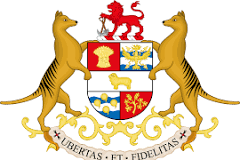Governmental policy surrounding endangered species changes, indicating that the population’s perspective has changed. Legal rights have changed due to shifts in moral responsibilities.
This is the Tasmanian Coat of Arms, featuring two thylacines. This is representative of the change in perspective that has occurred, as the animal is now revered instead of loathed.

Tasmanian Government, Tasmanian Coat of Arms, 1917